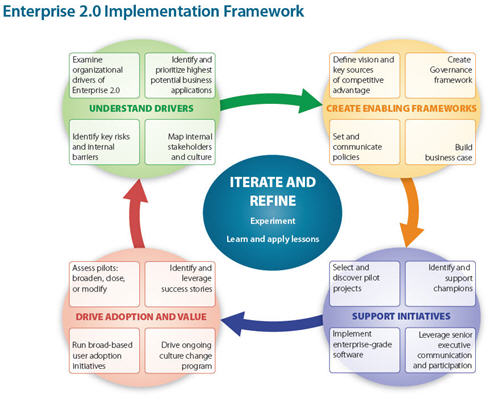Launch of Implementing Enterprise 2.0 Framework
A centrepiece of our recently launched Implementing Enterprise 2.0 report is an Implementing Enterprise 2.0 Framework. Click on the image below to download the Implementing Enterprise 2.0 Framework pdf, which includes references to the relevant chapters for each of the action steps. Some of the chapters referred to are available for download from the Implementing Enterprise 2.0 downloads page.
The central aspect of the framework is that it is iterative. Where you begin on the cycle depends on your organization. Some will begin in the upper left domain of Understanding Drivers, by understanding the drivers. Others will start in the lower right domain of Supporting Initiatives by identifying and supporting existing initiatives that people have begun of their own initiative.
No effective detailed master plan can be created for Enterprise 2.0. A key aspect of how you undertake Enterprise 2.0 initiatives is deliberately to experiment, learn lessons, and refine over time. As I wrote recently, implementing Enterprise 2.0 can drive real competitive advantage specifically because it lies at the intersection of culture and technology, and thus is applied uniquely in every organization.
The priorities within each domain will vary across organizations. Creating Enabling Frameworks will be important for every firm, however the relative importance of for example building a business case and creating a governance framework will depend on organizational size, culture, and structure.
Much of the ongoing work is in Driving Adoption and Value. Many organizations have experienced that what seem like highly promising initiative have simply failed to gain traction. Traditional approaches to user adoption, culture change, and internal communication are useful, but need to be adapted for Enterprise 2.0.
We have used this framework in Version 1.0 of Implementing Enterprise 2.0. Like everything in the report, the framework will be developed and refined for future releases of the report, so any feedback and input will definitely be taken into account as we make this framework more useful and relevant.
What do you think? What are your suggestions for improving this?

